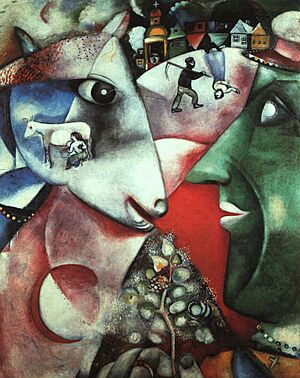I and the Village facts for kids
Quick facts for kids I and the Village |
|
|---|---|
 |
|
| Artist | Marc Chagall |
| Year | 1911 |
| Catalogue | 78984 |
| Medium | Oil on canvas |
| Dimensions | 192.1 cm × 151.4 cm (75.6 in × 59.6 in) |
| Location | Museum of Modern Art, New York |
| Accession | 146.1945 |
I and the Village is a famous oil painting created in 1911 by the artist Marc Chagall. He was a Belarusian-French artist known for his unique style. You can see this painting today at the Museum of Modern Art in New York City.
Contents
What is I and the Village?
This painting shows a dreamlike world. It mixes many soft, floating images together. The style is a bit like Cubism, an art movement that breaks things into geometric shapes. But Chagall uses it in a softer, more imaginative way.
Looking Closely at the Painting
In the front of the painting, you see a man with a green face wearing a cap. He is looking at a goat or a sheep. On the animal's cheek, there is a smaller goat being milked. The man holds a glowing tree in his dark hand. He also wears a necklace with a special cross called St. Andrew's cross.
In the background, you can spot some houses. There is also an Orthodox church. You might notice an upside-down woman playing the violin. She is in front of a man dressed in black who holds a scythe. A scythe is a tool used for cutting grass or crops.
The Story Behind the Art
The painting's name, I and the Village, gives us a big clue. It is all about Chagall's memories of his hometown. He grew up in a small village in Belarus. This artwork shows his feelings and connection to that place.
Memories and Imagination
This painting is special because it blends different parts of Eastern European folk tales. It includes ideas from both Belarusian and Yiddish cultures. Chagall used his childhood memories to create this "cubist fairy tale." He didn't worry about natural colors, sizes, or even if things followed gravity. His imagination made everything possible.
The painting uses clear symbols, like The Tree of Life. Its playful and imaginative style was very new and exciting at the time. It showed how art could be like a dream, full of personal stories and feelings.
See also
- List of artworks by Marc Chagall
Sources
- Charlotte Douglas, Jeannene M. Przyblyski, I and the village: early works, Jewish Community Museum, 1987
- Rosenblum, Robert. Cubism and Twentieth-Century Art. New York: Harry N. Abrams, 1966.

